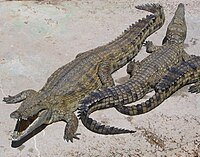
Modulation of nutrient utilization, growth, and immunity of Nile tilapia, Oreochromis niloticus: the role of probiotics
Sign Up to like & getrecommendations! Published in 2019 at "Aquaculture International"
DOI: 10.1007/s10499-019-00463-6
Abstract: The production of Nile tilapia, Oreochromis niloticus, over the last few years has increased due to the adoption of intensive farming technologies. However, the continuous increase in O. niloticus production must be based on sustainable… read more here.
Keywords: tilapia oreochromis; nutrient utilization; oreochromis niloticus; growth ... See more keywords

Characterizing the genetic structure of introduced Nile tilapia (Oreochromis niloticus) strains in Tanzania using double digest RAD sequencing
Sign Up to like & getrecommendations! Published in 2019 at "Aquaculture International"
DOI: 10.1007/s10499-019-00472-5
Abstract: Tilapia hatcheries in Tanzania rely heavily on importing germplasm. Nevertheless, the genetic structure of the imported stocks is poorly understood. In the current study, the level of genetic diversity and differentiation of eight populations of… read more here.
Keywords: tilapia oreochromis; oreochromis niloticus; tilapia; structure ... See more keywords

Microbiological investigation of Tilapia lake virus–associated mortalities in cage-farmed Oreochromis niloticus in India
Sign Up to like & getrecommendations! Published in 2021 at "Aquaculture International"
DOI: 10.1007/s10499-020-00635-9
Abstract: Tilapia lake virus (TiLV) is a serious pathogen of farmed Nile tilapia (Oreochromis niloticus) responsible for significant mortalities. In this study, we investigated a disease outbreak in cage-farmed Nile tilapia in India. The infected fish… read more here.
Keywords: veronii; tilapia lake; virus; nile tilapia ... See more keywords

Anthropogenic impacts on the contextual morphological diversification and adaptation of Nile tilapia (Oreochromis niloticus, L. 1758) in East Africa
Sign Up to like & getrecommendations! Published in 2017 at "Environmental Biology of Fishes"
DOI: 10.1007/s10641-017-0704-0
Abstract: Nile tilapia occurs naturally in East Africa where it’s an economically important species. Many of the natural populations of Nile tilapia have been affected by anthropogenic activities including translocations, associated with programmes aimed at enhancing… read more here.
Keywords: diversification; anthropogenic activities; natural populations; tilapia ... See more keywords

Bioremediation treatment improves water quality for Nile tilapia (Oreochromis niloticus) under crude oil pollution
Sign Up to like & getrecommendations! Published in 2020 at "Environmental Science and Pollution Research"
DOI: 10.1007/s11356-020-09020-8
Abstract: Despite favorable publicity of bioremediation as an affordable technology for cleanup of crude oil, public concerns on ecological safety in the presence of residual oil remain a global challenge. In this study, effects of crude… read more here.
Keywords: bioremediation; bioremediation treatment; crude oil; oil ... See more keywords

Toxicity of palm oil mill effluent on the early life stages of Nile tilapia (Oreochromis niloticus, Linnaeus 1758)
Sign Up to like & getrecommendations! Published in 2020 at "Environmental Science and Pollution Research"
DOI: 10.1007/s11356-020-09410-y
Abstract: Harmful effects of several pollutants have been reported on early life stages of fish. However, the effects of palm oil mill effluent (POME) on fish early life stages are still unexplored. Therefore, the objective of… read more here.
Keywords: life stages; stages nile; early life; rate ... See more keywords

Miswak (Salvadora persica) modulated the growth performance, antioxidative response, and histopathological damage induced by zinc toxicity in Nile tilapia (Oreochromis niloticus)
Sign Up to like & getrecommendations! Published in 2020 at "Environmental Science and Pollution Research"
DOI: 10.1007/s11356-020-09429-1
Abstract: In this study, Nile tilapia fingerlings with average body weight (8.6 ± 0.06 g) were exposed to zinc (Zn) toxicity and tested its amelioration with miswak (Salvadora persica L.) (SP) supplemented diet. Five fish groups… read more here.
Keywords: salvadora persica; miswak salvadora; zinc toxicity; nile tilapia ... See more keywords

The effects of dietary clinoptilolite and chitosan nanoparticles on growth, body composition, haemato-biochemical parameters, immune responses, and antioxidative status of Nile tilapia exposed to imidacloprid
Sign Up to like & getrecommendations! Published in 2021 at "Environmental Science and Pollution Research"
DOI: 10.1007/s11356-021-12693-4
Abstract: This study aimed at the evaluation of the mitigating effects of dietary zeolites (ZEO) and/or chitosan nanoparticle (ChNP) on imidacloprid (IMID)-induced toxicity in Nile tilapia (Oreochromis niloticus). Fish (18.03 ± 0.01 g) were allocated into… read more here.
Keywords: growth; zeo; compared ctr; effects dietary ... See more keywords

In Vitro Evaluation of the Probiotic and Safety Properties of Bacteriocinogenic and Non-Bacteriocinogenic Lactic Acid Bacteria from the Intestines of Nile Tilapia and Common Carp for Their Use as Probiotics in Aquaculture
Sign Up to like & getrecommendations! Published in 2017 at "Probiotics and Antimicrobial Proteins"
DOI: 10.1007/s12602-017-9312-8
Abstract: In this study, seven bacteriocinogenic and non-bacteriocinogenic LAB strains previously isolated from the intestines of Nile tilapia and common carp and that showed potent antibacterial activity against host-derived and non-host-derived fish pathogens were assayed for… read more here.
Keywords: safety properties; safety; nile tilapia; non bacteriocinogenic ... See more keywords

Comparative histochemical study of the gastrointestinal tracts of the Nile tilapia (Oreochromis niloticus) and the hybrid catfish (Clarias batrachus x Clarias gariepinus).
Sign Up to like & getrecommendations! Published in 2019 at "Acta histochemica"
DOI: 10.1016/j.acthis.2019.01.003
Abstract: Because of the wide variety of cells which are arrayed in the tissue of the gastrointestinal tracts of these two fish, basic histological examination is not appropriate to clarify the histological structure. But histochemical techniques… read more here.
Keywords: intestine; hybrid catfish; clarias; gastrointestinal tracts ... See more keywords

Antioxidants and immune responses, resistance to Aspergilus flavus infection, and growth performance of Nile tilapia, Oreochromis niloticus, fed diets supplemented with yeast, Saccharomyces serevisiae
Sign Up to like & getrecommendations! Published in 2020 at "Animal Feed Science and Technology"
DOI: 10.1016/j.anifeedsci.2020.114484
Abstract: Abstract Yeast, Saccharomyces cerevisiae, is a single cell fungus, which contains various immune-stimulant compounds such as β-glucans, nucleic acids, oligosaccharides and chitin among others. So, it has been used as a probiotic in aqua-feeds. A… read more here.
Keywords: yeast saccharomyces; tilapia oreochromis; oreochromis niloticus; flavus infection ... See more keywords